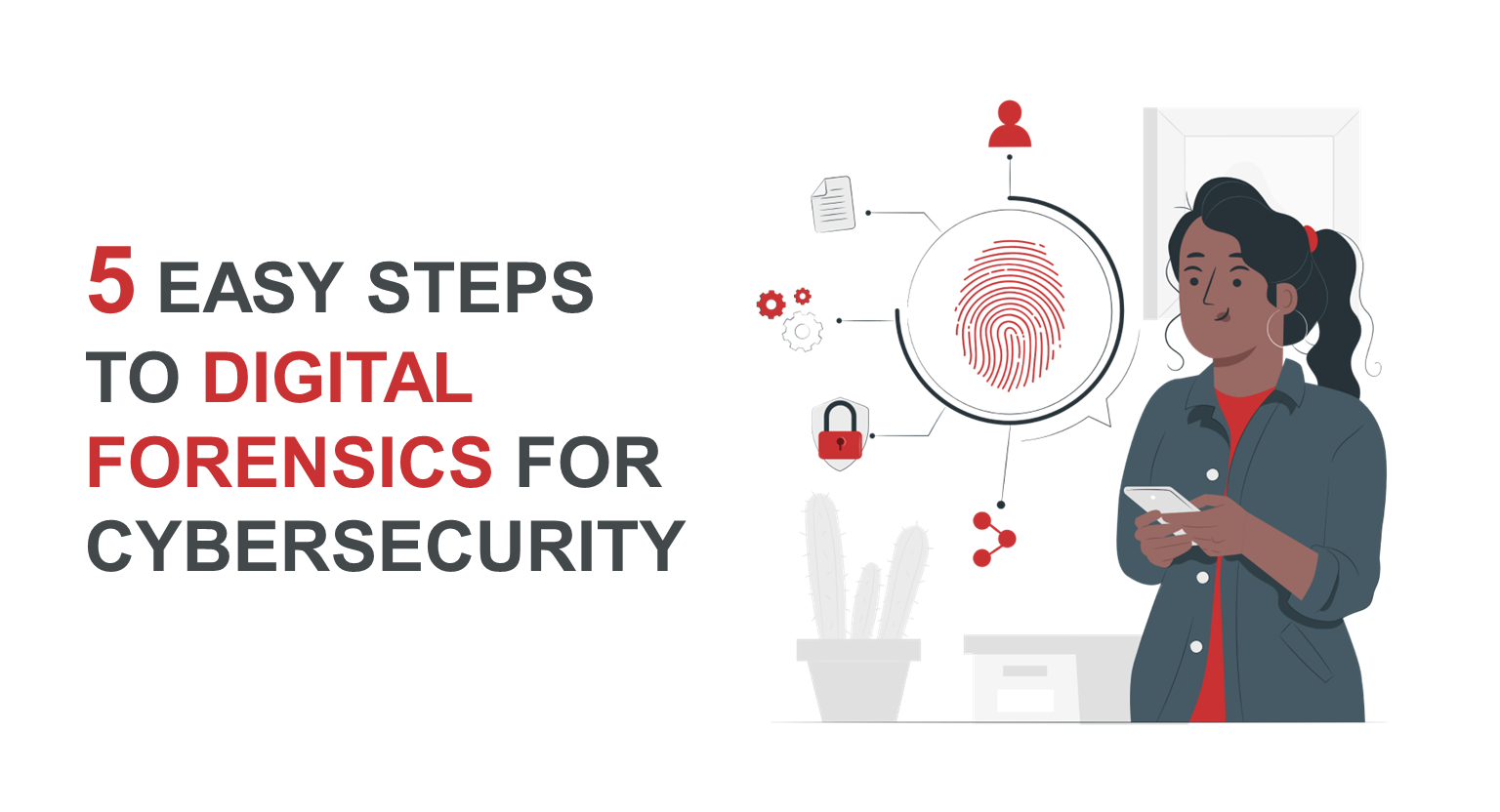5 easy Steps to digital forensics for Cybersecurity

1 Minutes 58 Seconds | 1446 views
Listen This Blog Now!
Introduction
Digital forensics is a critical aspect of cybersecurity. It involves the collection, preservation, analysis, and presentation of electronic data as evidence in a legal proceeding. Digital forensics is also used to investigate and respond to cybersecurity incidents, such as data breaches, ransomware attacks, and other cybercrimes.
5 easy steps to digital forensics for cybersecurity
-
Identification and Collection of Digital Evidence
The first step in digital forensics is to identify and collect digital evidence. This includes collecting data from devices such as computers, servers, mobile devices, and other storage media. This data can include log files, emails, chat messages, documents, and other types of digital files. It is essential to collect the evidence in a forensically sound manner to ensure that it is admissible in court.
-
Preservation of Digital Evidence
Once the digital evidence is collected, it must be preserved to ensure its integrity. The preservation of digital evidence involves creating a forensic copy of the original data and ensuring that the copy is not modified in any way. This ensures that the original data remains intact and can be used as evidence in a court of law.
-
Analysis of Digital Evidence
The next step in digital forensics is to analyze the collected digital evidence. This involves examining the data to identify any relevant information that can be used to determine the cause of the incident, the extent of the damage, and the identity of the perpetrator. The analysis of digital evidence can also provide valuable insights into the organization's security posture and help prevent future incidents.
-
Reporting and Presentation of Findings
The fourth step in digital forensics is to report and present the findings of the analysis. This involves presenting the findings in a clear and concise manner that is easy to understand. The report should include a summary of the incident, an analysis of the digital evidence, and any recommendations for improving the organization's security posture.
-
Remediation and Prevention
The last step in digital forensics is to remediate the incident and prevent future incidents. This involves implementing the recommendations provided in the report and taking steps to improve the organization's security posture. This may include upgrading security systems, implementing new policies and procedures, and providing employee training on cybersecurity best practices.
Conclusion
In conclusion, digital forensics is an essential component of cybersecurity. It helps organizations investigate and respond to cybersecurity incidents and provides valuable insights into their security posture. By following these five easy steps to digital forensics, organizations can ensure that they are adequately prepared to respond to any cyber incident and protect their digital assets. Ready to enhance your organization's cybersecurity strategy with digital forensics? Contact CyberNX today to learn more about our services and solutions.
Table Of Content
- Introduction
- 5 Easy Steps to digital Forensics for Cybersecurity
- Identification and Collection of Digital Evidence
- Preservation of Digital Evidence
- Analysis of Digital Evidence
- Reporting and Presentation of Findings
- Remediation and Prevention
- Conclusion
Introduction
Digital forensics is a critical aspect of cybersecurity. It involves the collection, preservation, analysis, and presentation of electronic data as evidence in a legal proceeding. Digital forensics is also used to investigate and respond to cybersecurity incidents, such as data breaches, ransomware attacks, and other cybercrimes.
5 easy steps to digital forensics for cybersecurity
-
Identification and Collection of Digital Evidence
The first step in digital forensics is to identify and collect digital evidence. This includes collecting data from devices such as computers, servers, mobile devices, and other storage media. This data can include log files, emails, chat messages, documents, and other types of digital files. It is essential to collect the evidence in a forensically sound manner to ensure that it is admissible in court.
-
Preservation of Digital Evidence
Once the digital evidence is collected, it must be preserved to ensure its integrity. The preservation of digital evidence involves creating a forensic copy of the original data and ensuring that the copy is not modified in any way. This ensures that the original data remains intact and can be used as evidence in a court of law.
-
Analysis of Digital Evidence
The next step in digital forensics is to analyze the collected digital evidence. This involves examining the data to identify any relevant information that can be used to determine the cause of the incident, the extent of the damage, and the identity of the perpetrator. The analysis of digital evidence can also provide valuable insights into the organization's security posture and help prevent future incidents.
-
Reporting and Presentation of Findings
The fourth step in digital forensics is to report and present the findings of the analysis. This involves presenting the findings in a clear and concise manner that is easy to understand. The report should include a summary of the incident, an analysis of the digital evidence, and any recommendations for improving the organization's security posture.
-
Remediation and Prevention
The last step in digital forensics is to remediate the incident and prevent future incidents. This involves implementing the recommendations provided in the report and taking steps to improve the organization's security posture. This may include upgrading security systems, implementing new policies and procedures, and providing employee training on cybersecurity best practices.
Conclusion
In conclusion, digital forensics is an essential component of cybersecurity. It helps organizations investigate and respond to cybersecurity incidents and provides valuable insights into their security posture. By following these five easy steps to digital forensics, organizations can ensure that they are adequately prepared to respond to any cyber incident and protect their digital assets. Ready to enhance your organization's cybersecurity strategy with digital forensics? Contact CyberNX today to learn more about our services and solutions.
Share this on: